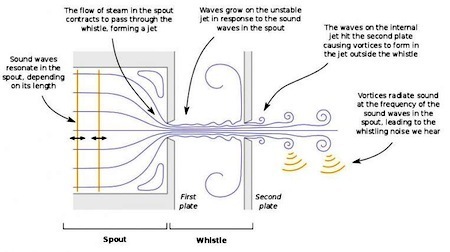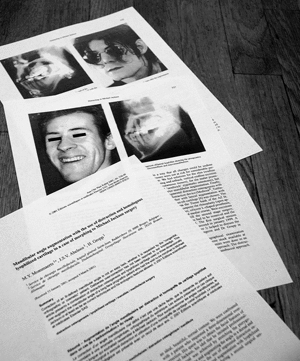Marc Abrahams's Blog, page 454
October 24, 2013
A British analysis of the physics of a tea kettle whistle
Another case of tea driving scientific effort and discovery:
“The aeroacoustics of a steam kettle,” R.H. Henrywood and A. Agarwal, Physics of Fluids, vol. 25, 2013, 107101. (Thanks to investigator Richard Baguley for bringing this to our attention.) The authors, at the University of Cambridge, UK, report:
“The whistle in a steam kettle provides a near-perfect example of a hole tone system, in which two orifice plates are held a short distance apart in a cylindrical duct. This setup leads to distinct audible tones for a large range of flow rates. The main objective of the current paper is to understand the physical mechanism behind the generation of hole tones (whistling of steam kettles). A variety of experiments were undertaken, primarily focusing on how the acoustics of the hole tone system varied depending on the flow rate, whistle geometry, and upstream duct length. These were supplemented by flow visualisation experiments using water. The results show that the whistle’s behaviour is divided into two regions of operation. The first, occurring at Reynolds numbers (based on orifice diameter and jet velocity) below Reδ ≈ 2000, exhibits a near-constant frequency behaviour. A mathematical model based on a Helmholtz resonator has been developed for this part of the mechanism. The second, for Reynolds numbers greater than Reδ ≈ 2000, the whistle exhibits a constant Strouhal number behaviour.”
R.H. Henrywood adds this image:
The two investigators are also known for investigating the physics of high-speed hand-dryers.
BONUS: The university issued a press release to celebrate the achievement. The press release says: “Researchers have finally worked out where the noise that makes kettles whistle actually comes from – a problem which has puzzled scientists for more than 100 years”. It then quotes R.H. Henrywood:
“Once we know where the whistle is coming from, and what’s making it happen, we can potentially get rid of it”.
BONUS: Video of an occasion on which Mr. Henrywood expertly sang the song “Gown of Green”:
BONUS: Jeremy Zander’s 2006 film dramatization of the late-night use of a steam kettle:

Nosy inquiry to members of a non-criminal student sample
This is possibly not the only study that focuses on a non-criminal student sample. It is one of the few that relies on both the Iowa Gambling Task and Sniffin’ Sticks:
“The Relationship Between Psychopathy and Olfactory Tasks Sensitive to Orbitofrontal Cortex Function in a Non-criminal Student Sample,” Travis M. Bettison, Mehmet K. Mahmut, Richard J. Stevenson, Chemosensory Perception, epub October 2013. (Thanks to investigator Neil Martin for bringing this to our attention.) The authors, at Macquarie University, Sydney, Australia, explain:
“This study investigated the relationship between psychopathy and tests presumed sensitive to orbitofrontal cortex (OFC) function in a non-criminal student sample. While converging lines of evidence indicate OFC-associated dysfunction in criminal psychopaths, few studies have investigated whether non-criminal psychopaths manifest similar deficits. Psychopathic traits were indexed using the Self-Report Psychopathy scale and the “Sniffin’ Sticks” and Iowa Gambling Task (IGT) were employed as neuropsychological measures of OFC function. The results showed higher degrees of psychopathy were significantly associated with poorer olfactory discriminative ability and poorer IGT performance. The discussion focuses on what these findings contribute to the understanding of the psychopathy and OFC relationship, suggesting the degree of OFC-associated dysfunction may be one differentiating factor between criminal and non-criminal psychopaths.”

October 23, 2013
Mathematigal: “A math major talks about fear”
Mathematigal, AKA Saramoira Shields, who majored in math and , talks to the camera about people fearing to major in math:
(HT Aatish Bhatia)

Progress in Head Mounted Flying Animal Feeders
Some of our readers will no doubt recognise (in the drawing above) David M. Leslie’s 1999 patent for a Wearable device for feeding and observing birds and other flying animals. The invention provided, perhaps for the first time, assistance for “Persons with a sincere and deep-rooted interest in birds” who “… often share an urge to be as close to the birds as possible when observing them.” A person wearing the patented hat could “… observe them from a relatively short distance, for example, of about 6-18 inches.”
Impressive though the Leslie hat was, some feel that improvements can still be made in the head mounted flying animal feeder arena. For recent advances, see the work of Theodore D. Hensley – granted a newly issued US patent (Sept. 24, 2013) – which, according to the inventor, is less cumbersome, and more comfortable “… to don”.
“The feeder apparatus comprises a tube having a consumable fluid, a feeding nozzle, and a perch. The feeder further comprises an extended arm providing a spring clamp which attaches to the hat brim. The feeder is positioned in front of the wearer’s face, thereby allowing for close observation of the hummingbird while it feeds. Additionally, the brim clip is designed in the shape of a mouth piece allowing a user to anchor the feeder in his/her mouth. “
Click the image or this link to see the User-mounted hummingbird feeder

October 22, 2013
Here a Dr. Frankenstein, there a Dr. Frankenstein…
Frankenstein, Frankenstein, wherefore art thou Frankenstein?
Wherefore can be a difficult question to answer properly. Where can be an easier question.

Richard S. Frankenstein, MD, FACP
Past President
California Medical Association
Where Dr. Frankenstein? There Dr. Frankenstein:
Frankenstein and the Cold Pressor Test
Frankenstein and the Immune-Body Cytokine Network
Frankenstein and the Effects of Intoxication on Alcoholics’ Marital Communication and Problem Solving
Frankenstein and the Reference Change Value of High-Sensitivity Troponin T in Healthy Individuals
Frankenstein and the Roots of the Ego
Frankenstein and the Peripheral Water Balance Control
Frankenstein and the Hollow Shaft Integrated Health Monitoring System for Railroad wheels

October 21, 2013
The tragedy of impulsive frotteurism
Another medical report about rubbing people the wrong way:
“Impulsive frotteurism: A case report,” Ambika Prasad Patra, Balaji Bharadwaj, Kusa Kumar Shaha, Siddhartha Das, Anand P. Rayamane, and Chandra Sekhara Tripathi, Medicine, Science and the Law, October 2013, vol. 53, no. 4, pp. 235-238. The authors, at Jawaharlal Institute of Postgraduate Medical Research, BGS Global Institute of Medical Sciences, and M.K.C.G. Medical College & Hospital, India, explain:
“Frotteurism is a perverted sexual behaviour wherein the person tends to rub or bring about physical contact between his genitals and an unrelated female or male to derive sexual pleasure. Moreover, frotteurism is a common phenomenon among the general population which usually goes unnoticed or overlooked. Nevertheless, public frottage has legal implications in almost all countries over the world…. This paper describes a 12-year-old boy having unrestrained impulsive frotteurism… Concurrent psychiatric counseling and rehabilitation measures were taken too. There was complete remission of the symptoms 6 months after the onset of treatment and without relapse thereafter. The paper discusses the differential diagnosis and management of hypersexual behaviour.”
(Thanks to investigator Erwin Kompanje for bringing this to our attention.)

Then: Michael Jackson surgery. Now: Justin Bieber surgery.
The Daily Mail reports the occurrence of surgery to make a British man look like singer Justin Bieber.
This follows in the tradition established by the surgeons who rearranged a Belgian man in an effort to make him look like singer Michael Jackson. The photo below shows some of the pages of the medical journal report on the Michael Jackson surgery. The citation for that report:
“Mandibular Angle Augmentation with the Use of Distraction and Homologous Lyophilized Cartilage in a Case of Morphing to Michael Jackson Surgery,” M.Y. Mommaerts, J.S. Abeloos, H. Gropp, Annales de Chirurgie Plastique et Esthetique, vol. 46, no. 4, August 2001, pp. 336-40.
BONUS: Detail on that historic Michael Jackson surgery
BONUS: What is said to be historic video footage of Justin Bieber himself undergoing a form of surgery:

Baseball cards: Bubblegum Card Bubbles
 Baseball cards – they’re collectible, and they can be worth something – and it’s been said (by some) that they’re “… a better investment than the stock market.” But is such a statement sound financial advice from dependable experts or misleading tittle-tattle from those with a vested interest (or neither) ?
Baseball cards – they’re collectible, and they can be worth something – and it’s been said (by some) that they’re “… a better investment than the stock market.” But is such a statement sound financial advice from dependable experts or misleading tittle-tattle from those with a vested interest (or neither) ?
Perhaps what’s needed is a serious academic study – and fortunately one (and maybe only one) exists. It comes from Artie Zillante, who is Associate Professor of Economics at the Belk College of Business, The University of North Carolina at Charlotte, US. The professor performs an in-depth examination of the subject in his working paper, entitled : ‘Bubblegum Card Bubble’. It looks at the rise (and subsequent fall) of the collectors’ market for baseball cards (originally given away with packs of bubblegum, cigarettes etc etc.) within a given time period.
So, are they a better investment?
“The primary contribution of this paper is to document the fluctuation in prices for baseball card sets from 1952-1988 over the time period 1988-2003. When doing so, some interesting facts appear. Sets from the1950s-1960s did not crash nearly as much as later sets. Sets from the 1970s initially (up to 1998) resemble those from the 1950s-1960s, but by 2003 it is clear that the 1970s sets are no longer similar to those from the 1950s-1960s as their prices have fallen almost 50% compared to only a 2-5% decline in set prices for the 1950s-1960s sets. The sets from the 1980s fare the worst, and provide solid evidence that items which are produced as collectibles/investments rarely hold their value.”
Notes:
[1] The card shows John Wesley “Jack” Glasscock (July 22, 1857 – February 24, 1947) when he was short stop for the Indianapolis Hoosiers,1888.
[2] Past performance should not be taken as an indication or guarantee of future performance. Certain investments are subject to high volatility, and may experience sudden large falls in their value. The value of stocks, shares, collections and other financial instruments can, and often do, fall as well as rise. Losses may equal or exceed your original investment. Apparently.

October 20, 2013
Startling Coffee Study of the Day: Ding’s “Coffee burns hepatic fat”
Today’s Startling Coffee Study of the Day is:
“Drinking coffee burns hepatic fat by inducing lipophagy coupled with mitochondrial β‐oxidation,” Wen‐Xing Ding, Hepatology (2013).

“Can students tell, based just on the titles and descriptions…”
From the NY Times blog “The Learning Network”, October 9, 2013:
On Cells and Nobels: Understanding and Modeling Prize-Winning Work on Vesicles
By JENNIFER CUTRARO and KATHERINE SCHULTEN
…Then project the following at the front of the room for students to read. Explain that these are all titles of articles published in various scientific journals. Two of them come from research that was awarded a Nobel Prize this week. Can students tell, based just on the titles and descriptions, which two are the Nobel Prize-winning work?
…
Answer: The two papers related to cell transport systems are part of the collection of papers included in this week’s Nobel Prize for Physiology or Medicine. See the “Going Further” section of this lesson to learn more about the others, which have been awarded “IgNobel Prizes.”…

Marc Abrahams's Blog
- Marc Abrahams's profile
- 14 followers







